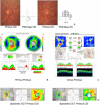Spectral domain-optical coherence tomography to detect localized retinal nerve fiber layer defects in glaucomatous eyes
- PMID: 19259242
- PMCID: PMC3465943
- DOI: 10.1364/oe.17.004004
Spectral domain-optical coherence tomography to detect localized retinal nerve fiber layer defects in glaucomatous eyes
Abstract
This study examines the ability of RTVue, Cirrus and Spectralis OCT Spectral domain-optical coherence tomographs (SD-OCT) to detect localized retinal nerve fiber layer defects in glaucomatous eyes. In this observational case series, four glaucoma patients (8 eyes) were selected from the University of California, San Diego Shiley Eye Center and the Diagnostic Innovations in Glaucoma Study (DIGS) based on the presence of documented localized RNFL defects in at least one eye confirmed by masked stereophotograph assessment. One RTVue 3D Disc scan, one RTVue NHM4 scan, one Cirrus Optic Disk Cube 200x200 scan and one Spectralis scan centered on the optic disc (15x15 scan angle, 768 A-scans x 73 B-scans) were obtained on all undilated eyes within a single session. Results were compared with those obtained from stereophotographs. In 6 eyes the presence of localized RNFL defects was detected by stereophotography. In general, by qualitatively evaluating the retinal thickness maps generated, all SD-OCT instruments examined were able to confirm the presence of localized glaucomatous structural damage seen on stereophotographs. This study confirms SD-OCT is a promising technology for glaucoma detection as it may assist clinicians identify the presence of localized glaucomatous structural damage.
Figures




References
-
- Medeiros FA, Zangwill LM, Bowd C, Vessani RM, Susanna R, Jr, Weinreb RN. Evaluation of retinal nerve fiber layer, optic nerve head, and macular thickness measurements for glaucoma detection using optical coherence tomography. Am. J. Ophthalmol. 2005;139:44–55. - PubMed
-
- Bagga H, Greenfield DS. Quantitative assessment of structural damage in eyes with localized visual field abnormalities. Am. J. Ophthalmol. 2004;137:797–805. - PubMed
-
- Jeoung JW, Park KH, Kim TW, Khwarg SI, Kim DM. Diagnostic ability of optical coherence tomography with a normative database to detect localized retinal nerve fiber layer defects. Ophthalmology. 2005;112:2157–63. - PubMed
-
- Budenz DL, Michael A, Chang RT, McSoley J, Katz J. Sensitivity and specificity of the StratusOCT for perimetric glaucoma. Ophthalmology. 2005;112:3–9. - PubMed
Publication types
MeSH terms
Grants and funding
LinkOut - more resources
Full Text Sources
Medical

